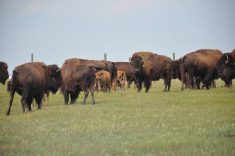The Canadian forage industry will soon have a new national body to represent its interests at home and abroad.
Forage producers, exporters, processors and provincial associations have joined forces after 16 months of planning to create the Canadian Forage and Grasslands Association.
“We’re incorporated and the association is moving ahead,” said Wayne Digby, executive director of the Manitoba Forage Council.
The Manitoba council played a lead role in forming the national association, according to its website, and the new organization will have its headquarters in Brandon.
Read Also

Canadian Food Inspection Agency extends chronic wasting disease control program consultation deadline
Date extended for consultation period of changes to CWD program
Digby said board members will be announced shortly.
“We’ve brought in all the provincial forage and grassland organizations across Canada.”
He said export companies and user groups such as the Canadian Cattlemen’s Association also support the new association.
Digby said issues for the group will include transportation, market development and research.
“There’s a huge need for research in the development of new forage varieties.”
The plan to replace the defunct Canadian Hay Association began at a forage workshop in Saskatoon in December 2008, Digby said.
“We brought many of the potential partner groups together (at that meeting).”
Glenn Friesen, a forage business development specialist with Manitoba Agriculture, said a national voice will make Canadian producers more competitive with countries that already have national forage associations, such as Australia and the United States.
“They (other countries) have got their ducks in a row … in terms of advocating for what they need for their (forage) producers.”
Digby expects the association will be launched in the next few weeks.
Benefits of including forages in rotations
- Increased soil fertility
- Improved soil quality
- Fewer weeds
- Higher yields and better quality in following grain crops
- Aid greenhouse gas reduction
Source: Manitoba Forage Council















